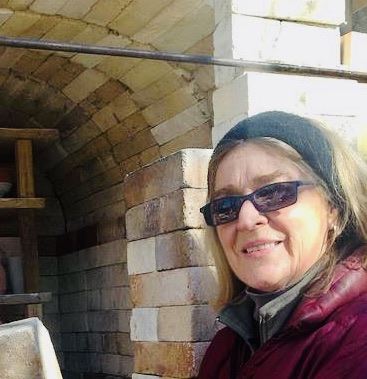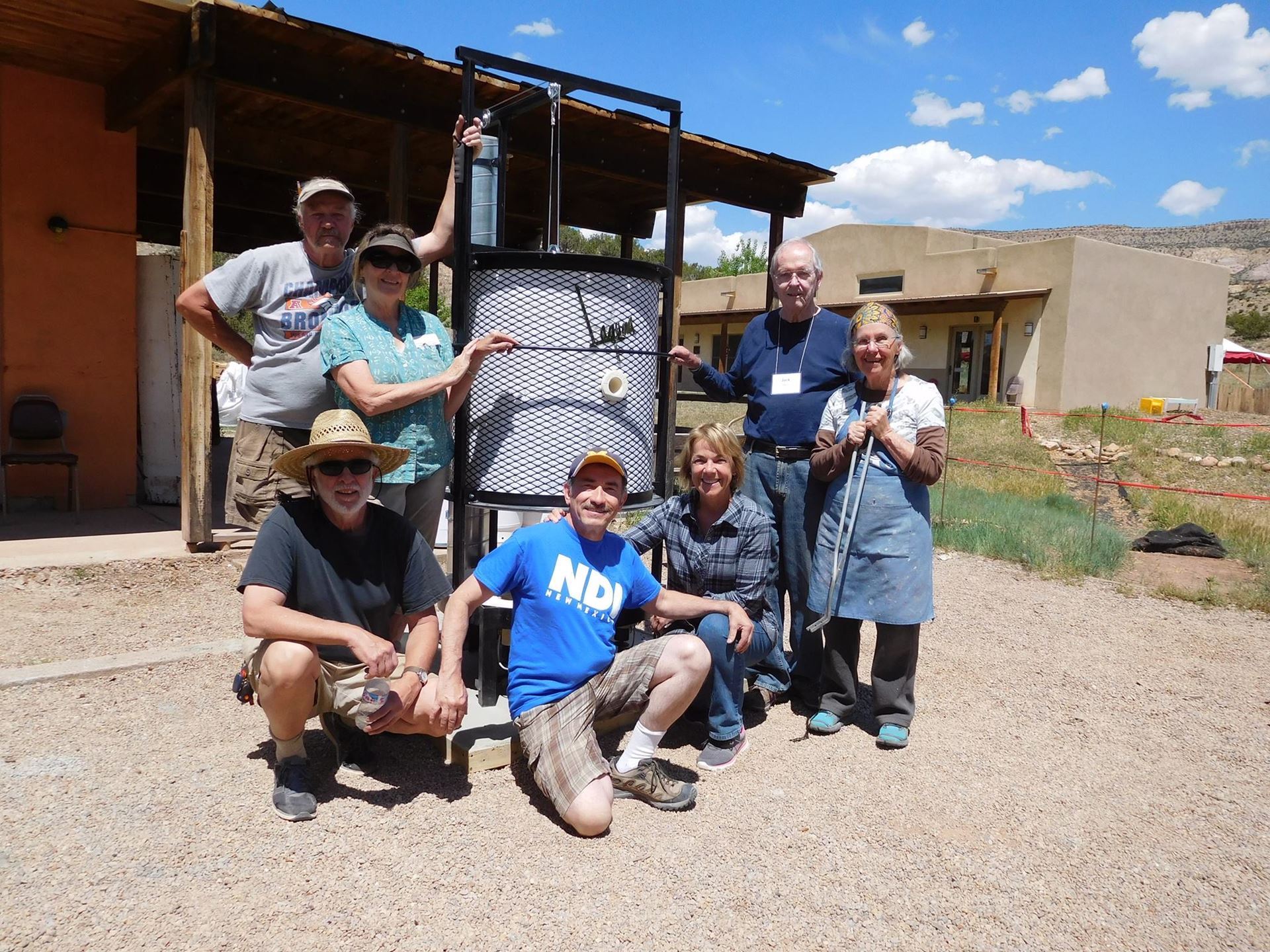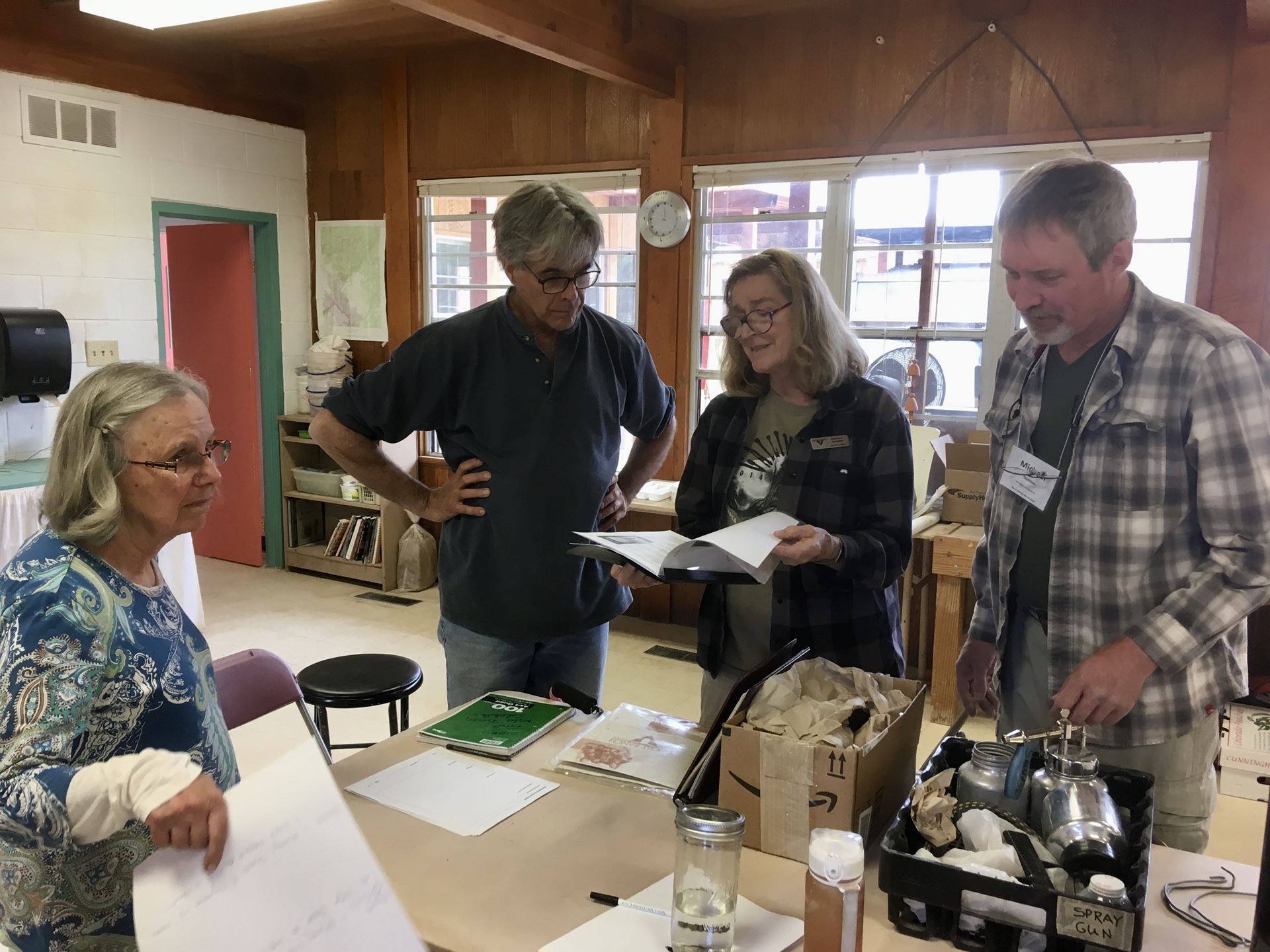 Part Two: Interview with Barbara Campbell
Part Two: Interview with Barbara Campbell
Barbara Campbell: Then a 27-foot flood came [July 7, 2015], and took out a lot of our equipment. It took the slab roller and dumped it upside down about 300 feet away. We found it 'cause its legs were sticking up out of the mud. All of the wood parts in the middle were pretty nasty and it was really rusted so I cleaned it all up. Somebody helped me build some struts for inside of it. It still could use one more piece of particle board in there right now. I usually put 2 or 3 pieces of canvas just to roll it a little thinner. So we managed to rescue that and it more or less works.
We moved up to Pinon #1. The Potters Association was fabulous. Dean Schroeder built all those indoor shelves and a counter around the sink. Joe Bova, Leonard Baca, and a few other people, I can’t remember who all else, built shelves along the side of the patio. First of all, I told the Ranch we needed more outdoor space. They moved all the kids’ equipment out of the way so we would have room for the kiln yard. The Ranch built us a patio that went out back from the smaller old patio, but it was a little too narrow. The Potters Association, again, raised $6000 for the retractable shades to come down so the afternoon sun doesn’t come across and fry people that are working on the patio. So, we have this nice shady area to make that patio very workable. The lattice work gives us some privacy without blocking people’s view or the much-needed air flow.

June 2016 “V” Camp: Dean Schroeder, Barbara Campbell, Tomas Wolff, Leonard Baca, Monika Kaden, Jack and Penne Roberts showing Raku kiln moved into "new" kiln yard. Photo credit: NMPCA.

May 2019 “V” Camp: Penne Roberts, David Canfield, Barbara Campbell, Michael Thornton review the Studio Manual. Photo credit: Cirrelda Snider-B.
Katie Sheridan donated the electric Bailey kiln that goes up to cone 10. It’s a lovely kiln. Because of the flood we no longer had a computer kiln. It’s really nice to have a computer kiln because if I can’t be there, that’s 4 or 5 hours I have to wait while I’m turning the kiln up before I can leave. One of our Jan Term teachers melted a batch of micaceous clay all over the inside of the Bailey kiln which totally ruined it, so we were down to one small funky kiln. It was then someone in Albuquerque, I can't remember who, had a computer for sale for $1,500. I asked our Program Director if the Ranch would buy it for us and they did.
Then, a year or two ago, Daniel Lauer from Albuquerque who works on kilns came up. Michael Thornton started cleaning all the melted micaceous clay out of the Bailey kiln. We kept one of the shelves that was completely destroyed. That shelf had the mica melted onto it like lava. There was one little space that was left bare and I found a lizard painted there, and a poem written by way of an apology. Michael started cleaning up the inside of the kiln. I asked the Ranch for the money to repair it. Buying a new kiln would be $3 or $4000 but we could probably repair it for under a thousand. Daniel Lauer came up and did an evaluation. I ordered all the parts he recommended. He later came up and rewired the whole kiln and put 2 courses of new bricks that were needed. He was the one who said you don’t want to be pulling a plug out and putting another plug in, on these other two kilns, he said, because it damages the metal, and eventually will start arching and you will burn up your sockets. They are really hard to get in and out and apparently it does damage each time you take it out. I had that happen to one of my kilns. My plugs are up high, under the eaves, because I have my kilns outdoors. Just the weight of the cord hanging, it eventually burned whole the whole plug and socket up when I wasn’t looking. Fortunately, it didn’t start a fire in my house, but it was all blackened. So, when I reinstalled it, I put a brace up there to hold the plug up so the weight wasn’t pulling. I understood the whole concept of that. We now just leave the computer kiln plugged in and we don't use the old small kiln that was so instrumental right after the flood. The small kiln was donated to the Ranch by Cricket Appel. I think it is time to pass that kiln along to the next person in need.
The Bailey kiln is hard-wired now. Everything is now working again. We also got the big gas kiln working. It turned out it was the sludge in the pipes leftover from the flood.
That’s the story of the maintenance. Everything is working now. Unfortunately, at the editing of this piece, we are having trouble with the gas lines again, and both the Raku kiln and the big gas kiln need some detective work on the pipes or basovalves or both. I will hopefully be working on these issues in the next few weeks as I have a throwing class starting on the 17th of September and would very much like to use the large gas kiln.
The Slip Trail: What a story. You also served on the board of NM Potters and Clay Artists.
Barbara Campbell: I did, I think I did a six-year stint and a year off and then another six-year stint. From the mid 90s until 2016 or 17 I can’t remember exactly when I went off the board.
The Slip Trail: So much interacting with Potters. If you hadn’t been chosen to replace Kempes, there might not have been such a great relationship. NM Potters had so much collaboration, gave so much hard work and time, and so much money was donated by them. And you were involved with NM Potters before the Ranch asked you to be coordinator.
Barbara Campbell: Part of it is that, and part of it was Judy, saying let’s get this going, and she was like the inspiration on a lot of the ideas. I can’t remember whose idea it was to have a volunteer camp. We were going to call it Work Camp, but Linda Kastner said, “Oh no, that sounds like Auschwitz. Call it Volunteer Camp.” That happened during that period of time. Early 2000s. Now we call it V-camp. I hope we will be able to do it again next spring. I think it is time.
It was Jim Kempes who needed to go back to work, as a teacher. He had been at the Ranch, he had taken care of Pot Hollow, all of the Festival of the Arts classes and all for more for many, many years before I came along. He had always been onsite when NM Potters did our workshops. We did a Spring one and a Fall one back then. He and Willard Spence. You know, Willard Spence was an older man who was part of the Bauhaus group from Taos, the two of them put Pot Hollow together to begin with. I would love to get Jim Kempes to tell his story. [see the interview in The Slip Trail here.]
The Slip Trail: Can you tell about the “TruGreen Pottery” course?
Barbara Campbell: Judy Nelson-Moore had done a couple of paper clay classes. You know with paper clay you can fire it/not fire it – deal with it how you want. She started talking about cold finishes and encaustic and she was always talking about this, that, and the other thing. And I thought, you know, wouldn’t it be fun to offer a class and call it TruGreen Clay partly because of the low carbon footprint because it is not going to be fired. But with Taxidermy clay you’re not supposed to fire it. That’s what I have been using. It’s very, very fibrous. And I don’t know what the fiber in it is. I should probably ask at NM Clay.
The Slip Trail: Sheep Dog?
Barbara Campbell: No, it’s called Taxidermy clay. It’s not to be fired. I think Sheepdog you can still fire it.
The Slip Trail: I’ve never done any of Judy’s paper clay workshops unfortunately.
Barbara Campbell: I did several of Judy’s workshops – and I helped her do one at Santa Fe Clay as her assistant. Then she did one up here at the Northern NM College before we actually got a space at the Ranch after the flood. She had four or five students. I got into it that way. I was thinking, wouldn’t it be nice to have a class where we didn’t have to fire. We were also talking about a class that was one day shorter. Because one of the things the Ranch wants to do is take advantage of the weeklong classes, but also accommodate the weekend people that come up. If the class goes until Saturday morning, that means people can only come up for Saturday night. Cleaning crew has a massive amount of stuff to do, so with everybody gone by Friday they can do it. They were looking for classes that could be one day shorter. I thought, it’s taken me ten years to figure out how to get it into this five-and-a-half-day period. Turning it into four-and-a-half-days was just not going to work for me, with the time firing entails. They are very happy to have a class that could be done in four days with no firing.
The Slip Trail: I love hearing about that. And it’s true, we need to learn how to not have to fire. I’m going to take it. Tell about the other classes you teach. Do you have a favorite?
Barbara Campbell: This year I’m going to be teaching Micaceous clay for one week, then Raku for the second week, then I’ll be teaching TruGreen for the third week. I think my favorite of course is the Raku always. I also like the Micaceous. What I’m going to do for that this summer is fire in the round brick kiln we brought up from Pot Hollow. And I will be using cedar for the firing. That will be fun.
You know, I like all of it.
A few months ago, I had a workshop in April with the TruGreen. The next week they called me and said there would be two groups of 20 ten-year-olds, and would I come give them a taste of pottery. They were going to go to Tony Roller’s down in Santa Clara, but he canceled. "Can you do something?" So, I said, "Sure." I only had them for three hours. Tomas Wolff, at one of our Potters Association workshops with 30 or 40 people, did this one drill where he had us take a piece of paper, write our name on it, write favorite color, favorite animal, something else, and something else - I can’t remember exactly what. Also, if you were introvert or extrovert. He then divided us into groups, and told us to build a village as a team using the information on our cards as a starting point. So, I did this with the kids. First of all, I asked these ten-year-olds if they knew the difference between an introvert and an extrovert. They were right on. First day it was word perfect, the second day it was just a little off, but it was close enough to be fine. Anyway, they divided up into groups of 4 and 5 and received a circle of clay or a square base slab of clay. I had them build animals while I was talking to them. They divided into the aquatic ones, four-legged, etc. They had a great time. They got finished about 45 minutes before the end of the period. Each group had a spokesperson and everybody crowded around and the spokesperson said what the village was all about, whether it was Romanesque or an under-seascape or a farmyard, or whatever. Everybody asked questions. First of all, we talked about how it was conceptual art. So, once they were done, they were done. They could use rocks and sticks, anything they wanted to incorporate into their environment. Then after they were done … I said, “Okay I’m going to give you a different kind of clay.” They were looking like, OMG. Aren’t we done yet? I handed them this Taxidermy clay and the minute they touched it, each and every one of them was totally back into it. It was kinda sticky, it was a way different texture than the clay they had been working with. Just to watch that transformation really delighted me. I told them once the pieces are dry, they’re finished. You don’t want to leave them outside, but you can take them home, you can paint them. They got to take something home. That was one of the most fun classes I have taught in a long time.
The Slip Trail: I think it’s brilliant that you gave them clay again. These are stories that needed to be told, Barbara. You are really there for the Ranch and ceramics education. I say, brava, Barbara, excellent job! I just want to say thank you. You are fabulous and we are lucky.
First two questions were presented by Barbara in written form. Interview for the rest of the questions took place on June 22, 2023 via Zoom, online.
- This conversation has been edited for length and clarity. -
-Cirrelda Snider-Bryan, Slip Trail Editor


